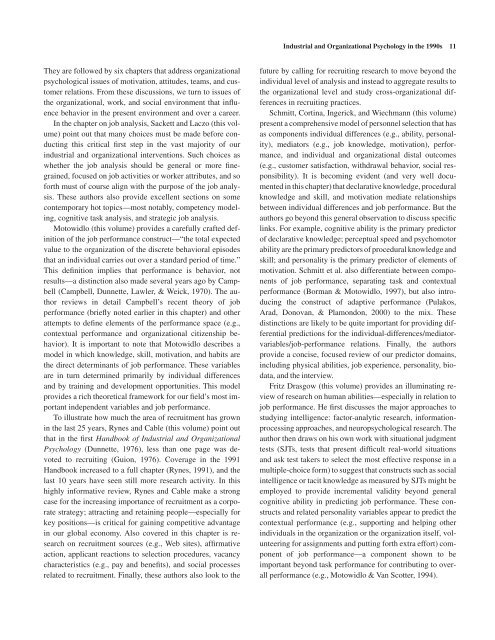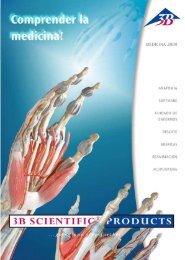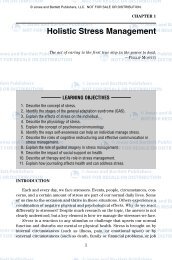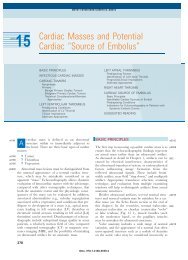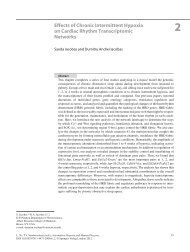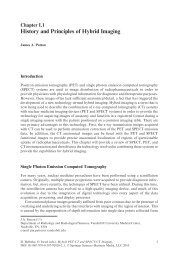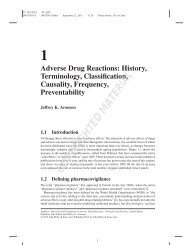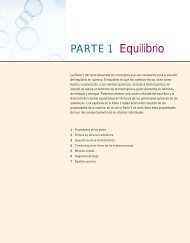Stability and Change in Industrial and Organizational ... - Axon
Stability and Change in Industrial and Organizational ... - Axon
Stability and Change in Industrial and Organizational ... - Axon
Create successful ePaper yourself
Turn your PDF publications into a flip-book with our unique Google optimized e-Paper software.
orm_ch01.qxd 9/26/02 2:59 PM Page 11<br />
They are followed by six chapters that address organizational<br />
psychological issues of motivation, attitudes, teams, <strong>and</strong> customer<br />
relations. From these discussions, we turn to issues of<br />
the organizational, work, <strong>and</strong> social environment that <strong>in</strong>fluence<br />
behavior <strong>in</strong> the present environment <strong>and</strong> over a career.<br />
In the chapter on job analysis, Sackett <strong>and</strong> Laczo (this volume)<br />
po<strong>in</strong>t out that many choices must be made before conduct<strong>in</strong>g<br />
this critical first step <strong>in</strong> the vast majority of our<br />
<strong>in</strong>dustrial <strong>and</strong> organizational <strong>in</strong>terventions. Such choices as<br />
whether the job analysis should be general or more f<strong>in</strong>egra<strong>in</strong>ed,<br />
focused on job activities or worker attributes, <strong>and</strong> so<br />
forth must of course align with the purpose of the job analysis.<br />
These authors also provide excellent sections on some<br />
contemporary hot topics—most notably, competency model<strong>in</strong>g,<br />
cognitive task analysis, <strong>and</strong> strategic job analysis.<br />
Motowidlo (this volume) provides a carefully crafted def<strong>in</strong>ition<br />
of the job performance construct—“the total expected<br />
value to the organization of the discrete behavioral episodes<br />
that an <strong>in</strong>dividual carries out over a st<strong>and</strong>ard period of time.”<br />
This def<strong>in</strong>ition implies that performance is behavior, not<br />
results—a dist<strong>in</strong>ction also made several years ago by Campbell<br />
(Campbell, Dunnette, Lawler, & Weick, 1970). The author<br />
reviews <strong>in</strong> detail Campbell’s recent theory of job<br />
performance (briefly noted earlier <strong>in</strong> this chapter) <strong>and</strong> other<br />
attempts to def<strong>in</strong>e elements of the performance space (e.g.,<br />
contextual performance <strong>and</strong> organizational citizenship behavior).<br />
It is important to note that Motowidlo describes a<br />
model <strong>in</strong> which knowledge, skill, motivation, <strong>and</strong> habits are<br />
the direct determ<strong>in</strong>ants of job performance. These variables<br />
are <strong>in</strong> turn determ<strong>in</strong>ed primarily by <strong>in</strong>dividual differences<br />
<strong>and</strong> by tra<strong>in</strong><strong>in</strong>g <strong>and</strong> development opportunities. This model<br />
provides a rich theoretical framework for our field’s most important<br />
<strong>in</strong>dependent variables <strong>and</strong> job performance.<br />
To illustrate how much the area of recruitment has grown<br />
<strong>in</strong> the last 25 years, Rynes <strong>and</strong> Cable (this volume) po<strong>in</strong>t out<br />
that <strong>in</strong> the first H<strong>and</strong>book of <strong>Industrial</strong> <strong>and</strong> <strong>Organizational</strong><br />
Psychology (Dunnette, 1976), less than one page was devoted<br />
to recruit<strong>in</strong>g (Guion, 1976). Coverage <strong>in</strong> the 1991<br />
H<strong>and</strong>book <strong>in</strong>creased to a full chapter (Rynes, 1991), <strong>and</strong> the<br />
last 10 years have seen still more research activity. In this<br />
highly <strong>in</strong>formative review, Rynes <strong>and</strong> Cable make a strong<br />
case for the <strong>in</strong>creas<strong>in</strong>g importance of recruitment as a corporate<br />
strategy; attract<strong>in</strong>g <strong>and</strong> reta<strong>in</strong><strong>in</strong>g people—especially for<br />
key positions—is critical for ga<strong>in</strong><strong>in</strong>g competitive advantage<br />
<strong>in</strong> our global economy. Also covered <strong>in</strong> this chapter is research<br />
on recruitment sources (e.g., Web sites), affirmative<br />
action, applicant reactions to selection procedures, vacancy<br />
characteristics (e.g., pay <strong>and</strong> benefits), <strong>and</strong> social processes<br />
related to recruitment. F<strong>in</strong>ally, these authors also look to the<br />
<strong>Industrial</strong> <strong>and</strong> <strong>Organizational</strong> Psychology <strong>in</strong> the 1990s 11<br />
future by call<strong>in</strong>g for recruit<strong>in</strong>g research to move beyond the<br />
<strong>in</strong>dividual level of analysis <strong>and</strong> <strong>in</strong>stead to aggregate results to<br />
the organizational level <strong>and</strong> study cross-organizational differences<br />
<strong>in</strong> recruit<strong>in</strong>g practices.<br />
Schmitt, Cort<strong>in</strong>a, Ingerick, <strong>and</strong> Wiechmann (this volume)<br />
present a comprehensive model of personnel selection that has<br />
as components <strong>in</strong>dividual differences (e.g., ability, personality),<br />
mediators (e.g., job knowledge, motivation), performance,<br />
<strong>and</strong> <strong>in</strong>dividual <strong>and</strong> organizational distal outcomes<br />
(e.g., customer satisfaction, withdrawal behavior, social responsibility).<br />
It is becom<strong>in</strong>g evident (<strong>and</strong> very well documented<br />
<strong>in</strong> this chapter) that declarative knowledge, procedural<br />
knowledge <strong>and</strong> skill, <strong>and</strong> motivation mediate relationships<br />
between <strong>in</strong>dividual differences <strong>and</strong> job performance. But the<br />
authors go beyond this general observation to discuss specific<br />
l<strong>in</strong>ks. For example, cognitive ability is the primary predictor<br />
of declarative knowledge; perceptual speed <strong>and</strong> psychomotor<br />
ability are the primary predictors of procedural knowledge <strong>and</strong><br />
skill; <strong>and</strong> personality is the primary predictor of elements of<br />
motivation. Schmitt et al. also differentiate between components<br />
of job performance, separat<strong>in</strong>g task <strong>and</strong> contextual<br />
performance (Borman & Motowidlo, 1997), but also <strong>in</strong>troduc<strong>in</strong>g<br />
the construct of adaptive performance (Pulakos,<br />
Arad, Donovan, & Plamondon, 2000) to the mix. These<br />
dist<strong>in</strong>ctions are likely to be quite important for provid<strong>in</strong>g differential<br />
predictions for the <strong>in</strong>dividual-differences/mediatorvariables/job-performance<br />
relations. F<strong>in</strong>ally, the authors<br />
provide a concise, focused review of our predictor doma<strong>in</strong>s,<br />
<strong>in</strong>clud<strong>in</strong>g physical abilities, job experience, personality, biodata,<br />
<strong>and</strong> the <strong>in</strong>terview.<br />
Fritz Drasgow (this volume) provides an illum<strong>in</strong>at<strong>in</strong>g review<br />
of research on human abilities—especially <strong>in</strong> relation to<br />
job performance. He first discusses the major approaches to<br />
study<strong>in</strong>g <strong>in</strong>telligence: factor-analytic research, <strong>in</strong>formationprocess<strong>in</strong>g<br />
approaches, <strong>and</strong> neuropsychological research. The<br />
author then draws on his own work with situational judgment<br />
tests (SJTs, tests that present difficult real-world situations<br />
<strong>and</strong> ask test takers to select the most effective response <strong>in</strong> a<br />
multiple-choice form) to suggest that constructs such as social<br />
<strong>in</strong>telligence or tacit knowledge as measured by SJTs might be<br />
employed to provide <strong>in</strong>cremental validity beyond general<br />
cognitive ability <strong>in</strong> predict<strong>in</strong>g job performance. These constructs<br />
<strong>and</strong> related personality variables appear to predict the<br />
contextual performance (e.g., support<strong>in</strong>g <strong>and</strong> help<strong>in</strong>g other<br />
<strong>in</strong>dividuals <strong>in</strong> the organization or the organization itself, volunteer<strong>in</strong>g<br />
for assignments <strong>and</strong> putt<strong>in</strong>g forth extra effort) component<br />
of job performance—a component shown to be<br />
important beyond task performance for contribut<strong>in</strong>g to overall<br />
performance (e.g., Motowidlo & Van Scotter, 1994).


